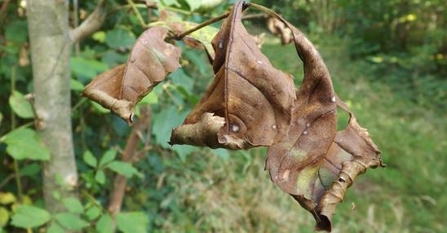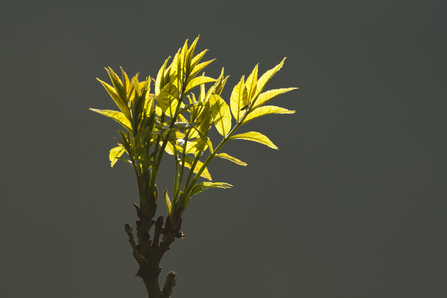
Infected ash leaf ©Steve Collin

Infected ash leaf ©Steve Collin
A knee-jerk reaction to dealing with ash die back in the UK may result in the wrong solution being found to tackle the disease, unnecessarily reducing our ashes to ashes.
Following the Government’s crisis committee Cobra meeting to discuss ash die back (on Fri 2 Nov), The Wildlife Trusts believe there are key questions1 still to be answered. The answers to these questions might lead to different short and long-term responses. We urge the Government to not be drawn in to knee-jerk and potentially damaging ‘solutions’.
Reports about 100,000 infected trees in nurseries being destroyed in a bid to prevent the disease spreading have led to speculation about the destruction of ash throughout the countryside. If the disease is widespread, this approach may be ineffective and could be counter-productive in the wider environment.
There are valuable lessons we can learn from recent disasters affecting our trees and woodlands. Dutch elm disease in the 1970s and the great storm of 1987, for example, illustrated that hasty reactions in the early stages of a crisis can result in the ‘cure’ being worse than the cause.
Paul Wilkinson, The Wildlife Trusts’ Head of Living Landscapes, said:
“In the immediate future any response to ash die back must take a precautionary and ecology-led approach. The roles of the Forestry Commission and FERA are crucial – they must be securely funded to develop the science so it can lead to the right practical action. The nature of any response will vary greatly depending on what we learn from a full study of the disease, the way it is spreading and its impact.
“The Government should invest in establishing the best way forward and in creating resilient habitats that can survive and adapt in the face of an increasing range of stresses and pressures. Reducing our ashes literally to ashes could devastate the environment and still have no effect on the disease.”
Ash trees are a vital component of woodland ecosystems and support a range of important plants and animals, from the brown hairstreak butterfly and hole-nesting birds such as owls and woodpeckers to lichens. They also support at least 60 of Britain’s rarest insects. Tree diseases - whether fungi, bacteria or viruses - are part of the natural cycle in woodland: a form of natural disturbance.

Mark Hamblin/2020VISION
Paul Wilkinson added:
“We must create a landscape that is ecologically diverse and resilient to the ‘shocks’ to which it may be exposed in the future. An environment in nature, with extensive, joined up habitats, is more likely to be able to cope with tree diseases. It is more likely to support trees that are genetically diverse, and so able to breed natural resistance. Such an environment is more likely to support habitats less easily damaged by the loss of occasional trees. It is our best insurance policy against disturbances like tree diseases.
"Ash trees are genetically diverse, unlike the English elms that were devastated in the 1970s, so it could be that some will have a level of resistance to ash die back. If we destroy all those considered infected, or that are near a source of infection, then a naturally resistant population may never emerge.
“We will be keeping a close eye on the Government to ensure it implements the recommendations of the Independent Forestry Panel, including plant and tree biosecurity. Its review of key conservation agencies must result in stronger and properly resourced champions of the natural environment which can help to ensure potential natural catastrophes are prevented in the future.”
Notes for editors:
1 Key questions to be answered: What is the nature of the fungus? Does it lie dormant and if so for how long? How is it spread? How far has it spread? How many trees and what area of woodland is infected? What is the distribution of vulnerable tree populations?
The Wildlife Trusts (TWT) wildlifetrusts.org
There are 47 individual Wildlife Trusts covering the whole of the UK. All are working for an environment rich in wildlife for everyone. We have more than 800,000 members including 150,000 members of our junior branch Wildlife Watch. Our vision is to create A Living Landscape and secure Living Seas. We manage around 2,300 nature reserves and every year we advise thousands of landowners and organisations on how to manage their land for wildlife. We also run marine conservation projects around the UK, collecting vital data on the state of our seas and celebrating our amazing marine wildlife. Every year we work with thousands of schools and our nature reserves and visitor centres receive millions of visitors. Each Wildlife Trust is working within its local communities to inspire people about the future of their area: their own Living Landscapes and Living Seas.